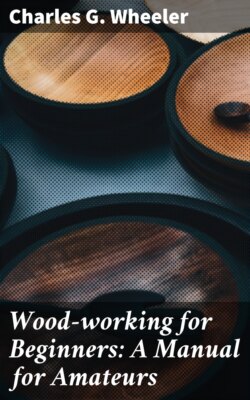Читать книгу Wood-working for Beginners: A Manual for Amateurs - Charles G. Wheeler - Страница 8
На сайте Литреса книга снята с продажи.
ОглавлениеFig. 5.
Fig. 6.
Fig. 7.
You can often cut better with a draw-stroke, i.e., not merely pushing the tool straight ahead, but drawing it across sideways at the same time (Fig. 7). You can press the sharp edge of a knife or razor against your hand without cutting, but draw the edge across and you will be cut at once. Even a blade of grass will cut if you draw the edge quickly through your hand, as you doubtless know.
If you try to push a saw down into a piece of wood, as you push a knife down through a lump of butter, or as in chopping with a hatchet, that is, without pushing and pulling the saw back and forth, it will not enter the wood to any extent, but when you begin to work it back and forth it cuts (or tears) its way into the wood at once. You know how much better you can cut a slice of fresh bread when you saw the knife back and forth than when you merely push it straight down through the loaf. You may have noticed (and you may not) how much better your knife will cut, and that the cut will be cleaner, in doing some kinds of whittling, when you draw it through the wood from handle to point (Fig. 7), instead of pushing it straight through in the common way, and you will discover, if you try cutting various substances, that as a general rule the softer the material the greater the advantage in the draw-stroke.
Now put the sharpest edge-tool you can find under a powerful microscope, and you will see that the edge, instead of being so very smooth, is really quite ragged—a sort of saw-like edge. Then look at the structure of a piece of wood as roughly indicated in Fig. 6, and you will understand at once just what we do when we cut wood with an edge-tool. You see the microscopically small sticks or tubes or bundles of woody fibre of which the big stick is composed, and you also see the microscopically fine saw to cut them. Now if the edge of the tool is fine you can often do the work satisfactorily by simply pushing the tool straight through the wood, but do you not see that if you can draw or slide the tool either back or forth the edge, being saw-like, will do its work better?
This stroke cannot be used of course in chopping with the axe or hatchet, splitting kindling-wood, or splitting a stick with the grain with a knife or chisel. In these operations the main principle is that of the wedge, pure and simple, driven through by force, the keen edge merely starting the cut, after which the wedge does the rest of the work by bearing so hard against the wood at the sides of the cut that it forces it to split in advance of the cutting edge, as in riving a log by the use first of an axe, then of an iron wedge, and finally a large wooden wedge (Fig. 8).
Fig. 8.
Practical directions and suggestions about the different Tools and their Uses and the various Operations will be found alphabetically arranged in Part V.
